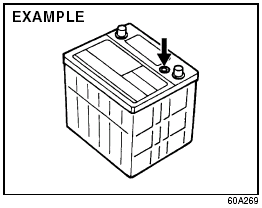Battery

Battery

WARNING:
Batteries produce flammable hydrogen
gas. Keep flames and sparks
away from the battery or an explosion
may occur. Never smoke when working
near the battery.

WARNING:
When checking or servicing the battery,
disconnect the negative cable.
Be careful not to cause a short circuit by allowing metal objects to contact the battery posts and the vehicle at the same time.

WARNING:
To avoid harm to yourself or damage
to your vehicle or battery, follow the
jump starting instructions in the
“EMERGENCY SERVICE” section of
this manual if it is necessary to jump
start your vehicle.

WARNING:
Battery posts, terminals and related
accessories contain lead and lead
compounds. Wash hands after handling.
Your vehicle is equipped with a battery that requires infrequent maintenance. You will never have to add water. You should, however, periodically check the battery, battery terminals and battery hold-down bracket for corrosion. Remove corrosion using a stiff brush and ammonia mixed with water, or baking soda mixed with water. After removing corrosion, rinse with clean water.
The test indicator on the top of the battery provides information on the condition of the battery.
If your vehicle is not going to be driven for a month or longer, disconnect the cable from the negative terminal of the battery to help prevent discharge.
See also:
Fuel Recommendation
Your vehicle requires regular unleaded
gasoline with a minimum rating of 87 pump
octane ((R + M)/2 method). In some areas,
the only fuels that are available are oxygenated
fuels.
Oxygenated fue ...
INTERIOR
While the interior fit and finish of the 2010 Kizashi still reads a bit
"cheap," there are some details that are better thought out. For example, the
fabric upholstery has a wood grain f ...
Cigarette Lighter and Ashtray
Cigarette Lighter (if equipped)
To use the cigarette lighter, push it all the
way into the receptacle and release it. It
will automatically heat up and will pop out
to its normal position when i ...
